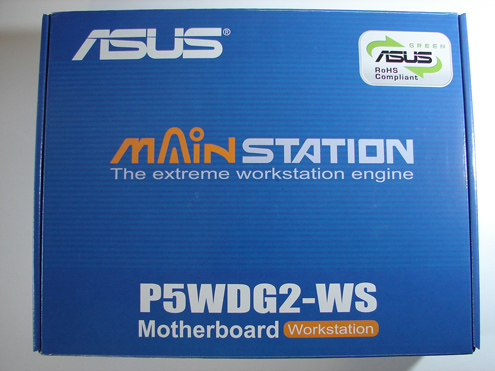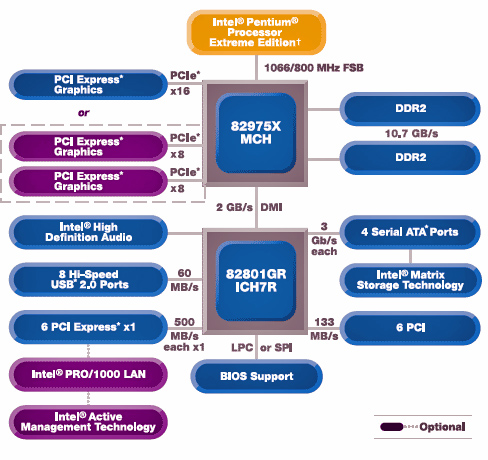Asus P5WDG2-WS: Intel 975X goes to Work
by Gary Key on December 6, 2005 12:05 AM EST- Posted in
- Motherboards
"An idea, to be suggestive, must come to the individual with the force of revelation."
This quote from the American philosopher and pragmatist William James led us to try a few different testing methodologies for today's article. We are reviewing the Asus P5WDG2-WS motherboard along with comparison scores to the Gigabyte GA-G1 975X. While the two boards are targeted for completely different audiences, both utilize Intel's excellent 975X chipset. Asus will be releasing the P5WD2-E for the enthusiast market in the near future and we will directly compare it to the Gigabyte GA-G1 975X at that time.

The Intel MPT has been enhanced to offer improved pipelining to enable a higher utilization of each memory channel, resulting in better performance through increased transfers between the processor and system memory. Intel Flex Memory Technology allows different memory sizes to be populated and still remain in dual-channel mode.
The new architecture also supports both asynchronous and isochronous data traffic, with dedicated internal pipelines and specialized arbitration. In addition, the 975X chipset has improved electricals with optimized ball-out for better latency.
The 975X chipset offers full support for graphic based PCI Express x16 lanes that can be configured as two PCI Express x8 slots for multi-view or GPU capability. The 975X chipset fully supports ATI CrossFire technology. Further technical details of the 975X chipset can be download in PDF format at Intel's website.
Asus chose to augment this feature set with additional SATA II capabilities via the Marvell 88SE6141 chipset, PCI-X capabilities via the Intel 6702PXH chipset, and Firewire 1394a support via the TI TSB43AB22 chipset.
Let's see how this board compares to others.










31 Comments
View All Comments
Cygni - Wednesday, December 7, 2005 - link
Workstation /= server...Overclocking isnt wacky in the worstation world at all. Picture a guy using 3dsmax everyday in his personal studio, or rendering TV streams in Maya, or doing texture work, or compiling source codes at a game studio...
Overclocking in the Workstation market is probably ALOT more common than people would think. Take overclocking that Pressler. That big of an overclock could mean whole DAYS of extra time per year that the CPU would have otherwise been spending cranking away on rendering. Thats a serious gain.
I dont think many serious servers will find a board like this one in em, to boot. Its lacking alot of features that a serious server hosting lots of users would deffinitly feel the need for... like built in SCSI, multi cpu support, RAM support over 8gig/4slot, etc.
On the other hand, this is a near perfect workstation board. High clocked RAM support for both ECC and non ECC. Non buffered memory. Both SLI and Crossfire support at 8x/8x. Plenty of SATA II plugs for cheap storage.
I took notice of the OC results and settings, and i like what i saw. :)
Cygni - Wednesday, December 7, 2005 - link
That was a reply to the poster one level up, sorry. :DThanks for taking the time to do the OC tests, however. Some people out there did like to see em.
Zebo - Tuesday, December 6, 2005 - link
If those 4.8ghz air overclocks are normal intel won't have to wait for conroe to take back enthusiasts crown. That's amazing.Leper Messiah - Tuesday, December 6, 2005 - link
Hell yeah. 4.8GHz on air with Dual core is a 20% over what an 840EE will do. And I bet that with nF4 and a DFI 5.0+ is possible. oooh. Sexay.stephenbrooks - Tuesday, December 6, 2005 - link
Yeah, I'm wondering if the Pentium D 920 might become a new "favourite" chip for them to play with :)Niv KA - Tuesday, December 6, 2005 - link
Talking about Conroe, isn't the 975X supposed to support upgradability to itxtremejack - Tuesday, December 6, 2005 - link
If you look at the chipset price guides for this month by Anand, 975x will not support ConroeGary Key - Tuesday, December 6, 2005 - link
Intel has not officially confirmed either way on the 975X to Conroe path. We have heard both a positive and negative on this but from different sources. As soon as we have a clear path it will be posted.Niv KA - Tuesday, December 6, 2005 - link
That would mean I could buy a 975X based MB with a Celeron and buy a Conroe in the summer without having to buy a new motherbord and allCalin - Tuesday, December 6, 2005 - link
When the graphs shows both min framerate and max framerate, I suggest that ordering should be done by the min framerate instead of the max framerate. Only on F.E.A.R. Performance test on the 9th page the results will change, and only for the top two boards - however, I prefer to have good consistent high framerate in the worst cases than extremely high framerate in the best conditions.Thanks